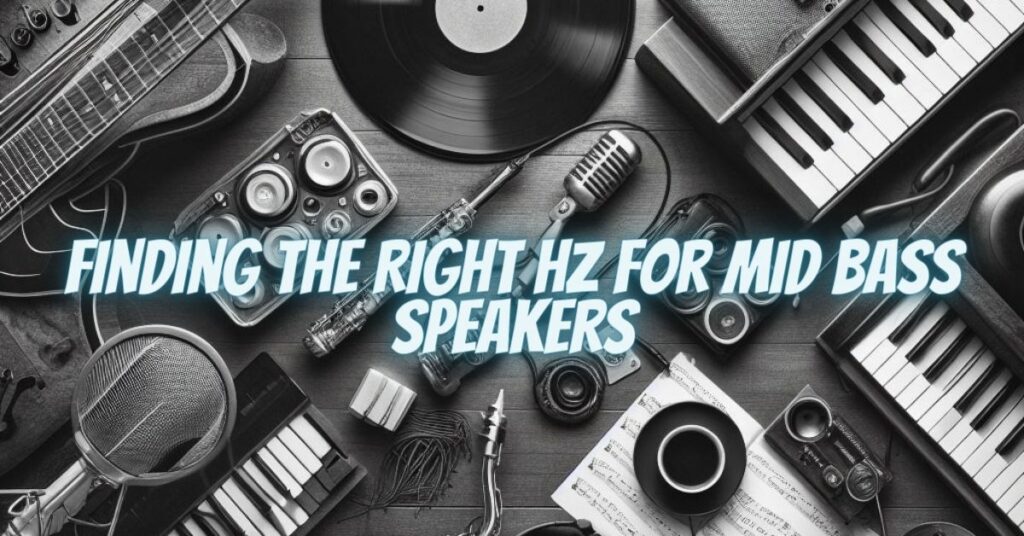Mid-bass speakers are integral components of any audio system, responsible for delivering the crucial mid-bass frequencies that bring warmth, punch, and character to music and audio. But what is the ideal Hertz (Hz) range for mid-bass speakers, and how can you optimize their performance to achieve the best sonic experience? In this article, we’ll delve into the world of mid-bass speakers, their ideal frequency range, and tips for getting the most out of them.
Understanding Mid-Bass Speakers
Mid-bass speakers are dedicated drivers designed to reproduce frequencies in the mid-bass range, which bridges the gap between the lower midrange and upper bass. This range typically includes frequencies between approximately 80Hz and 250Hz and plays a crucial role in providing warmth, body, and impact to music and audio content.
The Ideal Frequency Range for Mid-Bass Speakers
The ideal Hertz range for mid-bass speakers typically falls within the 80Hz to 250Hz range. Within this spectrum, you’ll find the fundamental frequencies of various musical instruments, such as the kick drum, bass guitar, lower-pitched vocals, and many other instruments that contribute to the richness and depth of sound.
Here’s a breakdown of this range:
- 80Hz – 120Hz: The lower part of the mid-bass range encompasses the fundamental frequencies of many bass instruments, including the kick drum and bass guitar. Boosting frequencies in this range can add depth and impact to your audio.
- 120Hz – 250Hz: In the upper mid-bass range, you’ll discover the warmth and fullness of instruments and vocals. Enhancing these frequencies can lead to a more robust and dynamic sound.
Optimizing Mid-Bass Speaker Performance:
To ensure that your mid-bass speakers perform at their best, consider the following tips:
- Speaker Selection: Choose mid-bass speakers that are specifically designed for this frequency range. Look for speakers with a balanced frequency response that covers the 80Hz to 250Hz range effectively.
- Crossover Settings: If your audio system employs a crossover between your main speakers and a subwoofer, set the crossover frequency to ensure a seamless transition for mid-bass frequencies.
- Room Acoustics: Pay attention to room acoustics, which can significantly impact mid-bass performance. Experiment with room treatments and speaker placement to address issues like standing waves and room resonances.
- Equalization (EQ): Use an equalizer to fine-tune mid-bass frequencies, adjusting the 80Hz to 250Hz range to achieve your desired sound profile. However, be cautious not to overdo it, as excessive EQ can result in distortion.
- Speaker Placement: Experiment with the placement of your mid-bass speakers to optimize their response in the mid-bass range. Avoid placing speakers too close to walls or corners, as this can lead to bass buildup, and find a placement that balances the sound.
- Room Calibration Systems: If your audio system supports room calibration tools, use them to automatically adjust mid-bass and other frequencies based on your room’s acoustics. These systems typically use microphones to measure room characteristics and adjust audio settings accordingly.
- Listening Preferences: Ultimately, your listening preferences should guide your mid-bass adjustments. Fine-tune the mid-bass range to achieve the sound that best suits your musical tastes and the content you enjoy.
The ideal Hertz range for mid-bass speakers, generally spanning from 80Hz to 250Hz, is crucial for adding warmth, depth, and impact to your audio experience. Optimizing mid-bass speaker performance involves careful speaker selection, consideration of room acoustics, the use of equalization, and thoughtful speaker placement. By paying attention to this essential frequency range and following these tips, you can harness the full potential of mid-bass speakers and enjoy a more dynamic and engaging audio experience.


